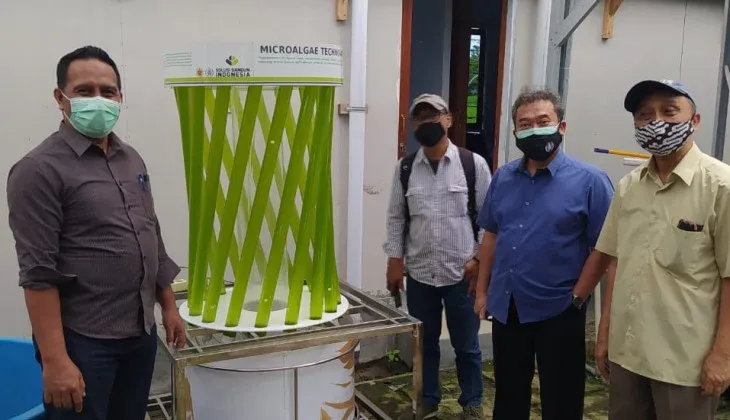Gadjah Mada University Designs Art Installation That Can Absorb CO2 Using Microalgae Technology
The Indonesian University of Gadjah Mada (UGM) successfully builds an art and technology installation called Algae TechnoArt. The creation combines microalgae photo-bioreactor technology with art in collaboration with the Indonesian Art Institute of Yogyakarta and PT. Solusi Bangun Indonesia (SBI).
The installation is claimed to be able to absorb CO2 emission more efficiently than trees. The installation is able to produce microalgae biomass. In the process, the algae is able to absorb CO2 emission in the air.

|
|
The Algae TechnoArt, designed by Gadjah Mada University and Indonesian
Art Institute of Yogyakarta. (Photo:
UGM) |
The director of the UGM microalgae development team, Prof. Arief Budiman, said that the photo-bioreactor design innovation also has an artistic value.
"Currently one installation has been installed in one of the subsidiaries of PT. SBI in Jakarta," said Professor Budiman on Monday (22/11), as quoted from UGM website.
The Chancellor of ISI Yogyakarta, Prof. Agus Burhan, also said that Algae TechnoArt, which was developed in collaboration with the UGM team, is not just a contemporary art. However, it also contains a processing technology that can produce a variety of products with various benefits.
"I think this is the first creation in Indonesia that combines art and processing technology," he said.
The professor also added that Algae TechnoArt is a unique and interesting invention. He stated that Alage TechnoArt conveys encouragement and the need to overcome issues of renewable energy, food security, and global warming.
"Everything is presented in contemporary art," added Professor Agus Burhan.
The microalgae is currently also being developed by the UGM team to manufacture biodiesel and bioavtur for aircraft fuel.
In the food sector, microalgae's nutritional content is quite diverse, ranging from high protein, Omega 3, anti-cancer compounds and other active components that can be used as super food. The remaining waste can also be used for livestock feeds.
Meanwhile, the Manufacturing Director of PT SBI, Lilik Unggul Raharja, said that his company supports the Paris Agreement in reducing CO2 emissions in Indonesia.
One concrete step is the installation of Algae TechnoArt in one of the subsidiaries of PT SBI. In the future, more installations will be installed in several locations.
"This installation, in terms of CO2 absorption, is equivalent to 4 years old four acacia trees. Of course this is suitable to be installed in places that are the sources of CO2 emissions," he said.
CO2 Absorption in Algae
Quoted from "Algae-Based Carbon Sequestration" by Cai Haoyang (2018), algae can absorb carbon-dioxide efficiently because of their comparatively short life cycles.
Algae can even reduce the amount of carbon-dioxide in the atmosphere more if we can support them with the appropriate environment, including temperature, nutrients (iron is one of the most important and effective ones), sunlight and the number of animals that eat them.
Thus, algae cultivation is a promising solution to reduce greenhouse effects.
Quoted from
Parametric Press,
one acre of algae
is able to remove up to 2.7 tons per day of CO2. Certain species of
microalgae have also been shown to efficiently remove CO2 in
environments at a rate of 10–50 times higher than terrestrial plants.
Post a Comment